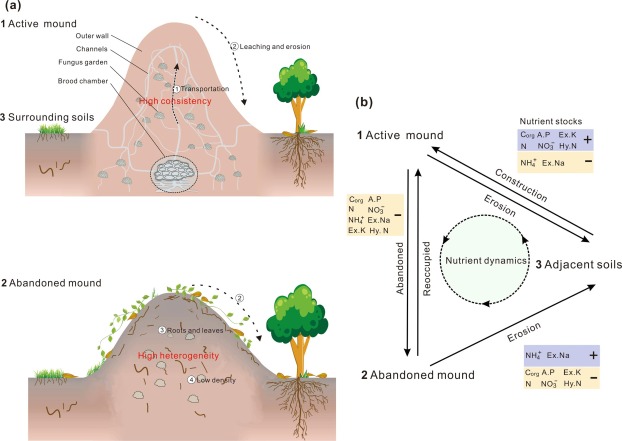Termites are considered to be ecosystem engineers. Fungus-growing termites could play an important role in soil nutrient availability and dynamics in humid and subhumid tropical ecosystems, by building numerous mounds with differing properties compared to adjacent soils. However, far less is known about the nutrient variability within the mounds and the nutrient stocks in whole mounds.
In a study published in journalCATENA, researchers from Xishuangbanna Tropical Botanical Garden (XTBG) investigated the spatial distribution of nutrients and their related nutrient stocks within active mounds (built by Odontotermes yunnanensis), abandoned mounds, and adjacent soils in Xishuangbanna, southwestern China.
The researchers mapped the spatial distribution patterns of nutrient concentrations within mounds and assessed the heterogeneity of nutrients inside mound structures. They also measured the nutrient stocks within the mounds according to the nutrient concentration and the bulk density of mound materials.
They found that the termite mounds of Odontotermes created “islands of fertility”, which differ from adjacent soils in physicochemical properties. The termite mounds were enriched in nutrients regardless of concentrations in the adjacent soil distributions, confirming that the termite mounds were “hot spots” of nutrients and indicating that adjacent soils were not the major factor affecting nutrient concentrations in the mounds.
Moreover, the termite mound structures can maintain a uniform distribution pattern of physicochemical properties. The active mounds showed high spatial homogeneity and weak or no spatial dependence of nutrient distributions (except for available P and exchangeable cations), whereas the abandoned mounds showed high heterogeneity and moderate or strong spatial dependence of nutrient distributions.
“Our study provides evidence supporting conjectures about the homogeneity of physicochemical properties within mound structures,” said Prof. LIU Wenjie, principal investigator of the study.
Contact
LIU Wenjie Ph.D Principal Investigator
Key Laboratory of Tropical Forest Ecology, Xishuangbanna Tropical Botanical Garden, Chinese Academy of Sciences, Mengla, Yunnan 666303, China
E-mail: lwj@xtbg.org.cn

Schematic diagrams illustrating (a) the fixation, distribution and cycles of the nutrients, and (b) the corresponding effects of termite mounds on nutrient dynamics. (Image by CHEN Chunfeng)

